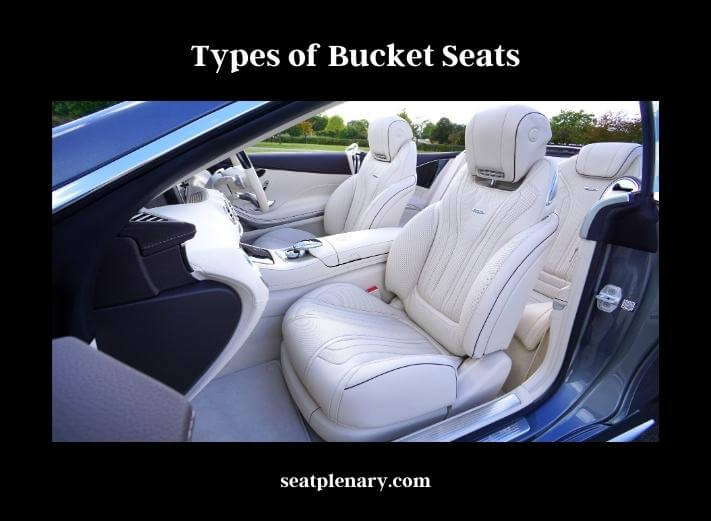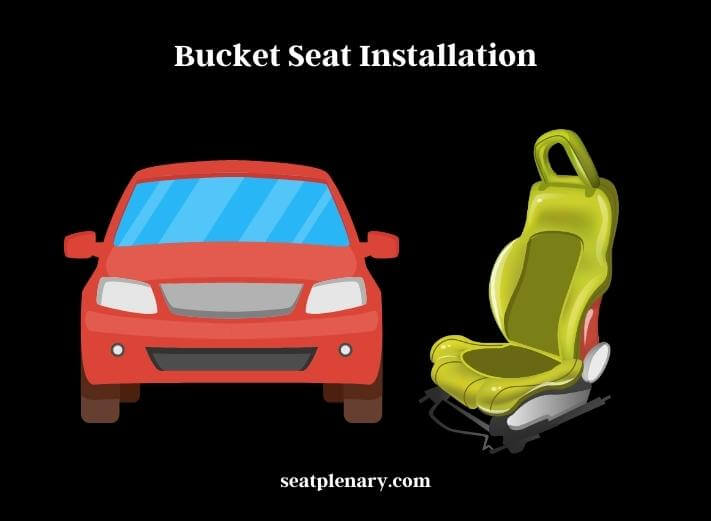Published on: May 16, 2024
Written by Evander Mac / Fact-checked by Jamal Haider
Bucket seats have become an iconic feature of modern automotive design. They are commonly found in sports cars, luxury vehicles, and even some trucks and SUVs. They are designed to provide comfort, support, and safety to drivers and passengers, making them an essential part of any vehicle.

The bucket seat design originated in the 1950s, primarily for use in sports cars. The original concept was to create a seat that would hold the driver securely in place during high-speed cornering and acceleration.
Over time, the design evolved, and bucket seats became more common in all types of vehicles. Today, bucket seats are found in everything from entry-level sedans to high-performance supercars.
The importance of bucket seats in automotive design cannot be overstated. They provide drivers and passengers with the support they need to stay comfortable during long trips, reduce the risk of back pain and fatigue, and enhance safety by keeping occupants securely in place during accidents. Bucket seats offer a sporty and stylish look that can add value and appeal to any vehicle.
Anatomy of Bucket Seats
Bucket seats consist of several components that work together to provide comfort and support. Understanding the anatomy of bucket seats can help you choose the right seat for your needs and maintain it properly.
The seat frame is the foundation of the seat and is responsible for holding the seat cushion and backrest in place. It is usually made of metal or high-strength plastic and is designed to withstand the stresses of everyday use. The frame is often designed with contours that provide additional support and help to keep the occupant in place during cornering and high-speed driving.
The seat cushion is part of the seat where the occupant sits. It is typically made of foam or other cushioning material and is designed to provide comfort and support.
The shape and contour of the seat cushion are essential to provide proper support to the occupant’s hips and thighs. Some high-performance bucket seats may have additional bolstering on the sides of the seat cushion to provide better support during cornering.
The backrest is part of the seat that supports the occupant’s back. It is also typically made of foam or other cushioning material and is designed to provide support and comfort.
The shape and contour of the backrest are crucial to providing proper support to the occupant’s back, especially during long trips. Some bucket seats may have adjustable lumbar support to provide additional comfort and reduce the risk of back pain.
The headrest is an optional feature that provides support to the occupant’s neck and head. It is usually attached to the top of the backrest and can be adjusted to provide proper support. The headrest is an essential safety feature, especially in the event of a rear-end collision, as it can help to prevent whiplash injuries.
Types of Bucket Seats
Bucket seats come in a variety of styles and materials, each with its own unique features and benefits. Here are some of the most common types of bucket seats:

Sport Seats
Sports seats are designed for high-performance driving and are commonly found in sports cars and race cars. They are typically made of lightweight materials such as carbon fiber or aluminum and feature aggressive bolstering to keep the driver securely in place during cornering and high-speed driving.
Racing Seats
Racing seats are similar to sports seats but are designed specifically for racing applications. They are usually made of composite materials and feature a harness or seatbelt pass-through to enhance safety.
Luxury Seats
Luxury seats are designed for comfort and style and are commonly found in high-end vehicles such as luxury sedans and SUVs. They are typically made of premium materials such as leather or Alcantara and may feature advanced features such as heating, cooling, and massage.
Classic Seats
Classic seats are designed to replicate the look and feel of vintage bucket seats from the 1950s and 1960s. They are often made of high-quality leather or vinyl and feature classic stylings such as diamond stitching and chrome accents.
Off-Road Seats
Off-road seats are designed for use in rugged vehicles such as trucks and SUVs. They are typically made of durable materials such as vinyl or cloth and feature extra padding and support to absorb shock and vibrations during off-road driving.
Bench Seats
Bench seats are a type of bucket seat that can accommodate multiple occupants. They are commonly found in older vehicles and may feature a split design to allow for more flexibility in seating arrangements.
Benefits of Bucket Seats
Bucket seats offer several benefits over traditional bench seats. Here are some of the most significant benefits of bucket seats:
Better Support
Bucket seats provide better support than traditional bench seats, especially during high-performance driving. The contoured shape of bucket seats helps to keep the occupant in place during cornering and high-speed driving, reducing the risk of injury and improving overall comfort.
Increased Safety
Bucket seats are designed with safety in mind. They are typically made of high-strength materials and feature advanced safety features such as headrests and seatbelt pass-throughs. These features help to reduce the risk of injury in the event of an accident.
Enhanced Comfort
Bucket seats are designed to provide enhanced comfort over traditional bench seats. They typically feature better padding and support, and some models may even have heating, cooling, or massage functions to provide additional comfort.
Customizable
Bucket seats are highly customizable, with a variety of materials, colors, and styles available. This makes it easy to find a seat that matches your personal preferences and vehicle style.
Improved Aesthetics
Bucket seats can improve the aesthetics of your vehicle’s interior. They often have a sporty or luxurious look that can enhance the overall appearance of your vehicle.
It’s important to know about future advancements in vehicle seat technology and design. here is the answer.
Reduced Fatigue
The improved support and comfort provided by bucket seats can reduce fatigue during long trips, making driving more comfortable and less tiring.
Bucket seats offer several benefits over traditional bench seats, including better support, increased safety, enhanced comfort, customizability, improved aesthetics, and reduced fatigue. These benefits make bucket seats a popular choice for drivers who value comfort, safety, and style.
Drawbacks of Bucket Seats
While bucket seats offer many benefits, they are not without their drawbacks. Here are some of the most significant drawbacks of bucket seats:
Limited Seating
Bucket seats are designed to accommodate only one occupant, which can be a significant drawback for families or groups of friends traveling together. This can make it difficult to transport multiple people, especially if your vehicle only has two seats.
Less Space
Bucket seats take up less space than traditional bench seats, which can be a disadvantage for larger or taller individuals. The narrow design of bucket seats can make it difficult to find a comfortable seating position, especially for those with wider hips or broader shoulders.
More Expensive
Bucket seats are typically more expensive than traditional bench seats, which can be a significant barrier for those on a tight budget. Higher-end bucket seats with advanced features such as heating, cooling, or massage can be even more expensive.
Not Suitable for All Vehicles
Bucket seats may not be suitable for all types of vehicles. They are commonly found in sports cars, racing cars, and high-end luxury vehicles but may not be practical for larger vehicles such as trucks or vans.
Less Versatile
Bucket seats are less versatile than traditional bench seats. They are designed primarily for high-performance driving and may not be as comfortable for daily commuting or long-distance travel.
Installation Can Be Complex
Installing bucket seats can be more complex than installing traditional bench seats. They may require modifications to your vehicle’s interior or custom mounting brackets, which can be time-consuming and expensive.
Bucket Seat Maintenance
Proper maintenance of your bucket seats is essential for keeping them in good condition and ensuring their longevity. Here are some tips for maintaining your bucket seats:
Regular Cleaning
Regularly clean your bucket seats to prevent dirt and grime buildup. Use a soft-bristled brush or a microfiber cloth to gently scrub the surface of the seats. Avoid using harsh chemicals or abrasive cleaners that can damage the material.
Stain Removal
If you spill something on your bucket seats, act quickly to prevent staining. Use a damp cloth to blot the area and avoid rubbing the stain, which can spread it further. For tougher stains, use a specialized upholstery cleaner designed for your seat material.
Protection
Consider using seat covers or protectors to protect your bucket seats from wear and tear. Seat covers are available in a variety of materials and styles, and they can help to extend the life of your seats and keep them looking new.
Lubrication
If your bucket seats have adjustable features such as lumbar support or reclining functions, lubricate the moving parts regularly to keep them working smoothly.
Inspection
Regularly inspect your bucket seats for signs of wear and tear, such as cracks or tears in the material. If you notice any damage, have it repaired as soon as possible to prevent further damage.
Storage
If you plan to store your vehicle for an extended period, cover your bucket seats with a breathable fabric to prevent dust buildup and protect them from sunlight and moisture.
Bucket Seat Installation
Installing bucket seats in your vehicle can be a great way to improve your driving experience and add a touch of style to your interior. Here are some tips for installing bucket seats:

| Choose the Right Seats | Before purchasing bucket seats, make sure they are compatible with your vehicle’s make and model. Check the dimensions and mounting points of the seats to ensure they will fit in your vehicle properly. |
| Remove the Old Seats | Remove the old seats from your vehicle carefully. Depending on the make and model of your vehicle, this process may involve removing bolts or screws and disconnecting electrical connections. |
| Install the Seat Brackets | Install the seat brackets provided with your new bucket seats. These brackets will typically bolt directly to the floor of your vehicle using the existing mounting points. |
| Mount the Seats | Once the brackets are installed, mount the bucket seats onto the brackets. Be sure to follow the manufacturer’s instructions for proper installation and torque specifications. |
| Connect the Electrical Connections | If your new bucket seats have electrical connections, such as power controls or heating elements, connect them according to the manufacturer’s instructions. |
| Test the Seats | After installation, test the seats to ensure they are secure and functioning properly. Adjust the seat positions and test the electrical connections to ensure everything is working as intended. |
| Final Adjustments | Make any final adjustments to the seats, such as adjusting the height or tilt, to ensure they are comfortable and properly positioned. |
Conclusion
Bucket seats offer a variety of benefits, including improved comfort, support, and style. They come in a range of materials and styles, from leather and suede to sporty racing-style seats. It’s important to weigh the benefits against the drawbacks, such as reduced accessibility and limited seating capacity.
Proper maintenance and installation are also crucial for getting the most out of your bucket seats. Regular cleaning, stain removal, protection, lubrication, inspection, and storage can help keep your seats in good condition and ensure their longevity. Similarly, following the manufacturer’s instructions and torque specifications for installing bucket seats can help ensure a safe and successful installation.
Bucket seats can be a great addition to your vehicle, providing improved comfort, support, and style. It’s important to consider the potential drawbacks and to properly maintain and install your seats for optimal performance and longevity.
If you want to know about car seat safety standards and ratings. Click here for this.
Relevant Resources:

